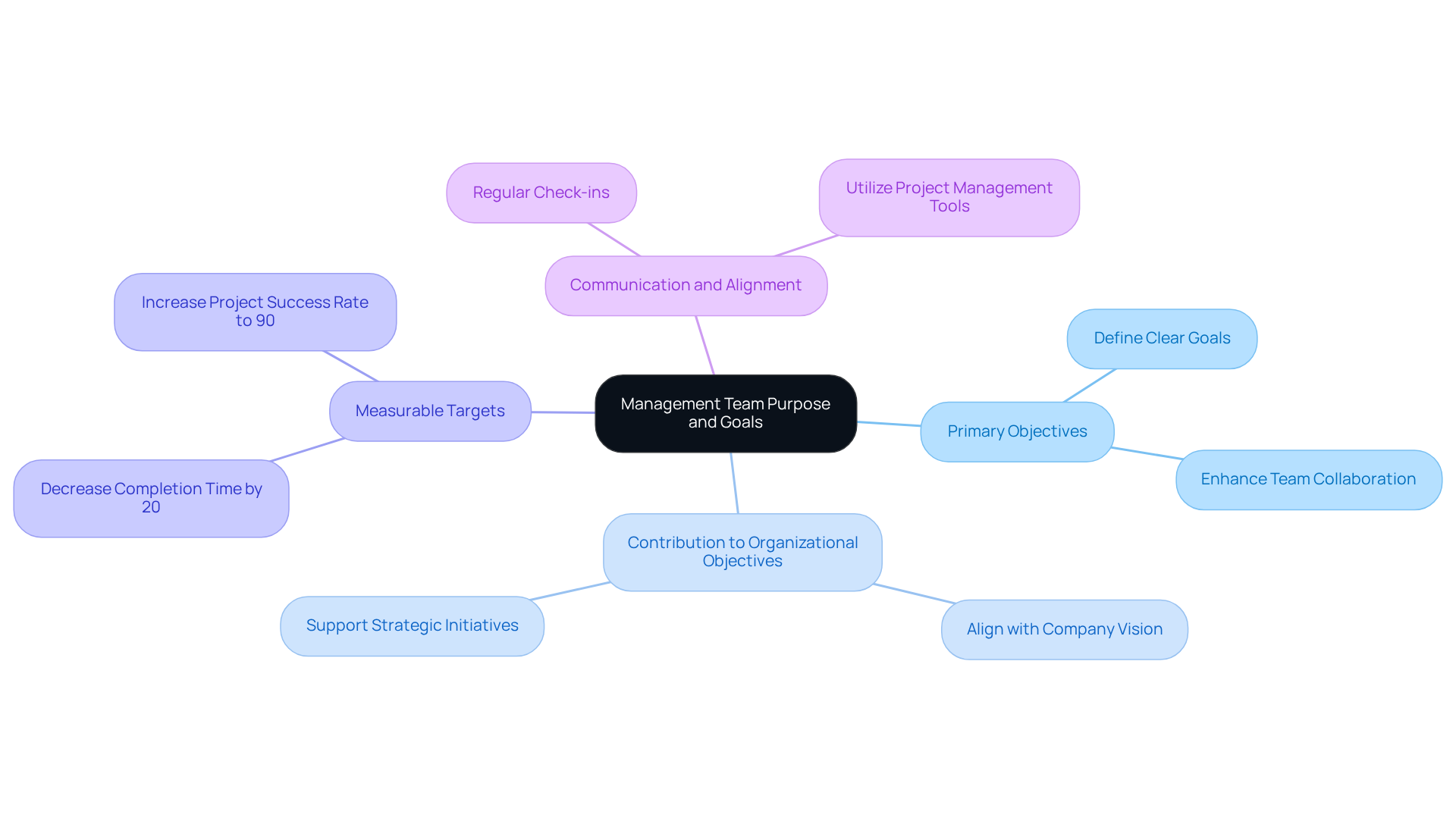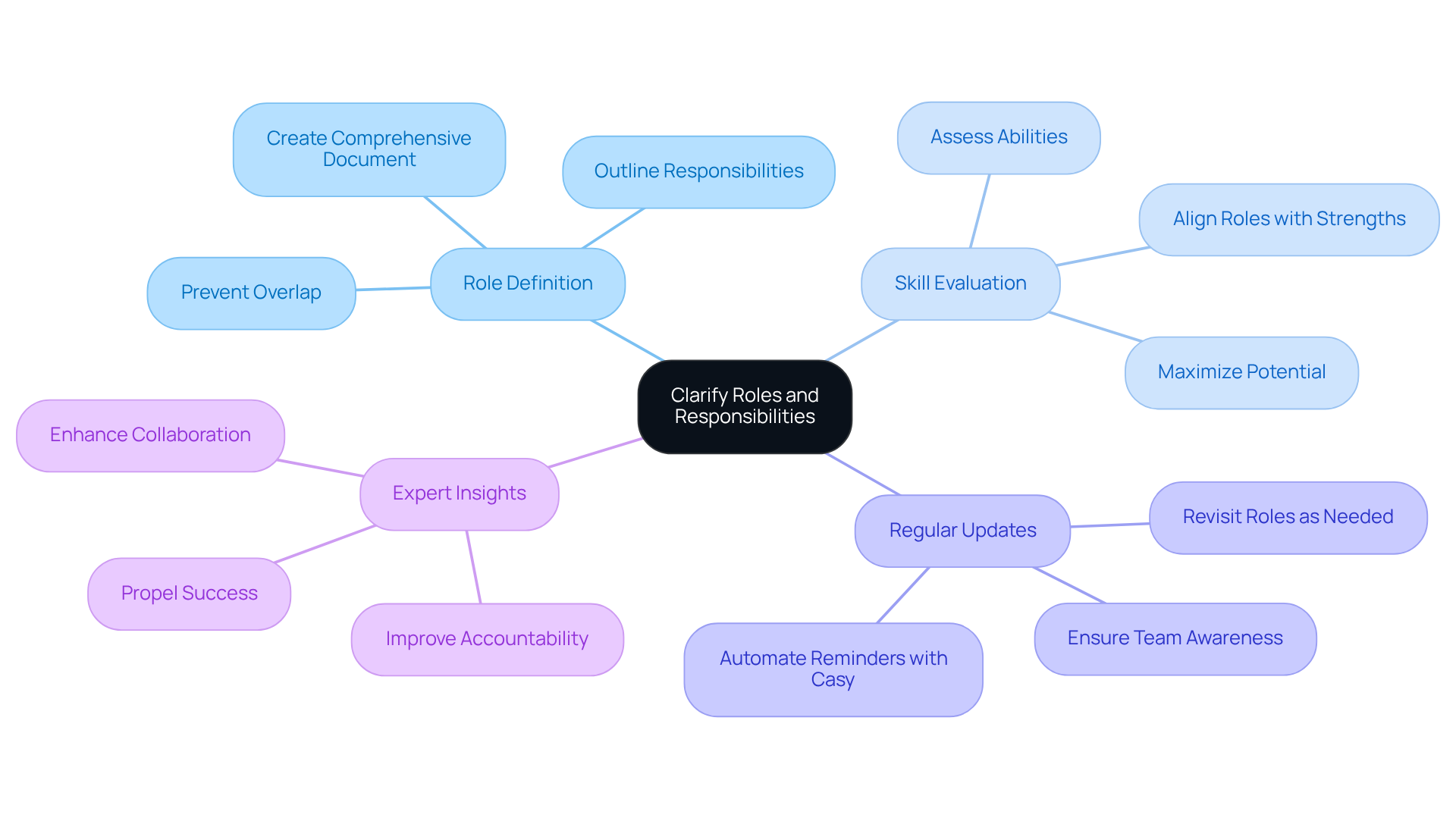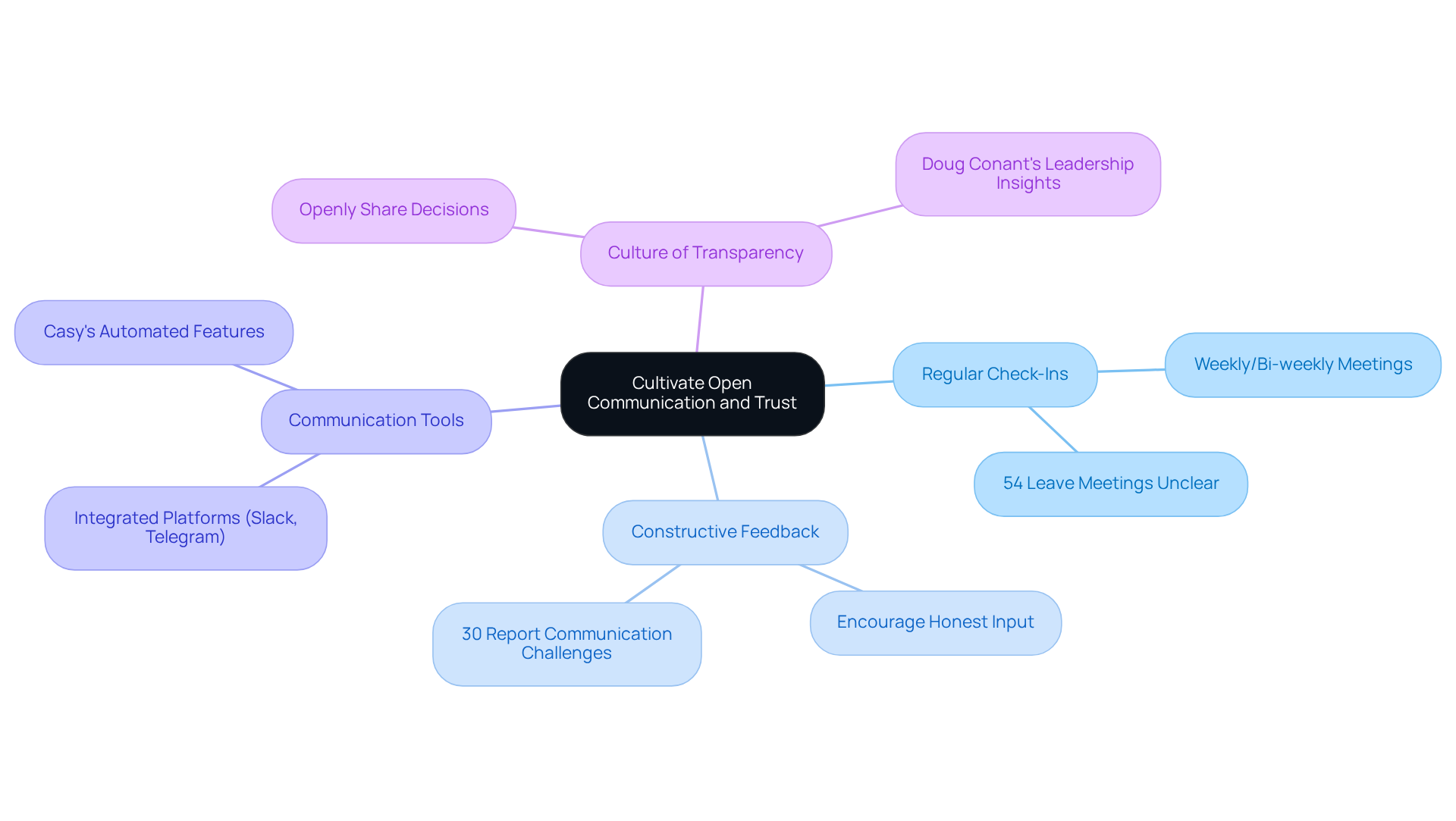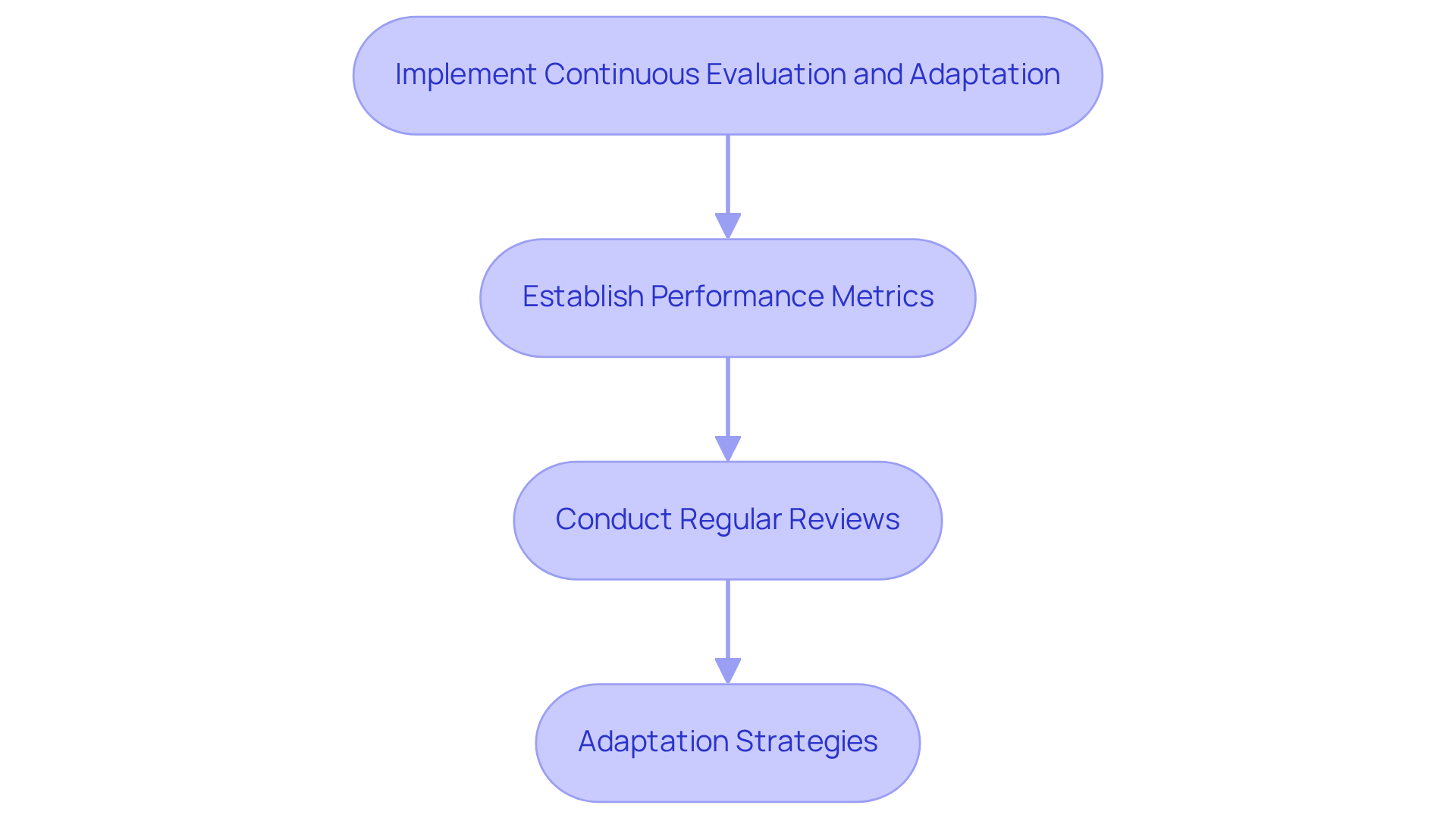Overview
The article centers on the critical steps necessary to construct an effective management team. These steps encompass:
- Defining purpose and goals
- Clarifying roles and responsibilities
- Fostering open communication
- Implementing continuous evaluation
To support these points, the article presents specific strategies and tools, such as:
- Setting measurable targets
- Utilizing communication platforms
- Conducting regular performance reviews
Each of these elements is designed to enhance team dynamics and achieve organizational objectives. How can these strategies transform your team's performance?
Introduction
Building a successful management team is pivotal in navigating the complexities of modern organizations. With a well-defined purpose and clear objectives, teams can drive performance and achieve remarkable results. However, the challenge lies in ensuring that every member understands their role and feels empowered to communicate openly.
How can leaders effectively cultivate an environment of trust and continuous improvement to unlock the full potential of their management teams?
Define the Purpose and Goals of Your Management Team
To build an effective management team, start by clearly defining its overarching purpose. Ask yourself:
- What primary objectives do we aim to achieve?
- How does this group contribute to the wider organizational objectives?
Once the objective is established, set specific, measurable targets for the group to pursue. For example, if the focus is on improving delivery, a quantifiable goal could be to decrease the average completion time by 20% within the upcoming quarter. Document these objectives and communicate them clearly to all group members to foster alignment and commitment.
Statistics reveal that organizations with clearly defined objectives achieve a 74% success rate in project completion, underscoring the importance of measurable targets for the management team. Additionally, 83% of companies employing the OKR framework report positive impacts on their operations, demonstrating the effectiveness of structured goal-setting methodologies.
To facilitate efficient monitoring of these objectives, consider utilizing tools like Casy, which integrates with chat platforms and automates the oversight process. This ensures that actionable tasks emerge from discussions among members. Such a method not only enhances visibility but also alleviates the administrative burden, allowing groups to focus on achieving their goals. Remember, as the saying goes, "A goal without a plan is just a wish.

Clarify Roles and Responsibilities Within the Team
Next, clarify the roles and responsibilities of each member of the management team. This can be achieved through:
-
Role Definition: Create a comprehensive document that outlines each member's responsibilities, including their specific tasks and areas of accountability. As Peter Drucker noted, 'Plans are only good intentions unless they immediately degenerate into hard work.' This clarity helps the management team prevent overlap and ensures that everyone understands their contributions to the project.
-
Skill Evaluation: Assess the abilities of each group member to ensure that roles align with their strengths. For instance, if an individual excels in data analysis, they might assume the position of performance metrics analyst, maximizing their potential and improving group performance. As Charles Darwin emphasized, 'It is not the strongest of the species that survives, nor the most intelligent. It is the one most adaptable to change.' This adaptability is crucial in aligning roles effectively.
-
Regular Updates: As initiatives progress, revisit and adjust roles as necessary to adapt to changing needs. Use Casy to automate reminders for these reviews, ensuring that everyone stays informed about their responsibilities. Casy supports unlimited groups, tasks, notes, and boards, making it adaptable for diverse workflows.
-
Expert Insights: Emphasizing the significance of role definition, specialists concur that when the management team clearly delineates responsibilities, it enhances collaboration and accountability, ultimately propelling success. By applying these strategies, groups can improve their effectiveness and adaptability in a dynamic work environment. Incorporating methodologies like OKRs and the Eisenhower Matrix within Casy can further assist in prioritizing tasks and ensuring that roles are aligned with project goals.

Cultivate Open Communication and Trust Among Team Members
To cultivate open communication and trust within management teams, consider implementing the following strategies:
-
Regular Check-Ins: Establish a routine of weekly or bi-weekly meetings to discuss progress, challenges, and feedback. This practice promotes an atmosphere of open conversation and responsibility, enabling individuals to voice concerns and share insights. Did you know that 54% of employees leave meetings without clarity about the next steps? This statistic underscores the necessity for structured check-ins.
-
Constructive Feedback: The management team should encourage group members to provide constructive feedback on processes and decisions. Utilizing anonymous surveys can facilitate honest input, ensuring that all voices are heard and valued. This is crucial for building trust, especially when 30% of employees report increasing challenges in communicating with coworkers and clients. Therefore, effective feedback mechanisms are essential.
-
Communication Tools: The management team should utilize communication tools by leveraging integrated platforms like Slack or Telegram with Casy to enhance real-time communication. This integration facilitates rapid updates and discussions without the need for formal meetings, significantly decreasing administrative burdens. With Casy's automated task creation and project planning features, teams can streamline communications further, allowing them to concentrate on their primary tasks.
-
Culture of Transparency: The management team should create a culture of transparency by openly sharing decisions and admitting mistakes. This builds trust and encourages group members to communicate openly, fostering a collaborative atmosphere where everyone feels empowered to contribute. Doug Conant emphasizes that trust is a necessity for effective leadership, reinforcing the importance of transparency in communication.

Implement Continuous Evaluation and Adaptation of Team Dynamics
To ensure optimal team dynamics, it is essential to implement a system for continuous evaluation and adaptation.
Performance Metrics: Establish key performance indicators (KPIs) to measure the effectiveness of the team. For instance, monitoring project completion rates and group satisfaction scores will provide valuable insights into performance.
Regular Reviews: Conduct quarterly evaluations to assess group performance against defined goals. These sessions not only celebrate successes but also identify areas for improvement, fostering a culture of growth.
Adaptation Strategies: Embrace the need to modify group structures or processes based on feedback and performance data. Casy can play a crucial role in tracking these changes, ensuring all team members are informed and aligned with new strategies.
How can your team leverage these practices for greater success?

Conclusion
Building an effective management team relies on a clear understanding of purpose, defined roles, open communication, and ongoing evaluation. Establishing specific, measurable goals aligns the team with organizational objectives, enhancing accountability and focus. By clearly defining roles and responsibilities, teams can leverage individual strengths, fostering a collaborative environment where each member contributes meaningfully to collective success.
The importance of cultivating trust and transparency among team members cannot be overstated. Regular check-ins, constructive feedback, and the use of integrated communication tools significantly improve team dynamics. Furthermore, implementing continuous evaluation and adaptation ensures that the management team remains agile and responsive to changing needs, ultimately driving performance and satisfaction.
In conclusion, the strategies outlined serve as a roadmap for organizations aiming to enhance their management teams. By prioritizing clear goals, role clarity, open communication, and regular assessments, teams can achieve their objectives and create a culture of collaboration and growth. Embracing these practices empowers management teams to navigate challenges effectively and lead with confidence, making a significant impact on overall organizational success.
Frequently Asked Questions
What is the first step in building an effective management team?
The first step is to clearly define the overarching purpose of the management team and establish primary objectives that align with the wider organizational goals.
How can specific goals be set for the management team?
Specific, measurable targets should be set for the group to pursue. For example, a quantifiable goal could be to decrease the average completion time by 20% within the upcoming quarter.
Why is it important to document and communicate objectives to team members?
Documenting and communicating objectives fosters alignment and commitment among group members, ensuring everyone is working towards the same goals.
What statistics highlight the importance of clearly defined objectives?
Organizations with clearly defined objectives achieve a 74% success rate in project completion. Additionally, 83% of companies using the OKR framework report positive impacts on their operations.
What tools can be used to monitor the objectives of the management team?
Tools like Casy can be utilized to integrate with chat platforms and automate the oversight process, enhancing visibility and reducing administrative burdens.
What is the significance of having a plan alongside goals?
Having a plan is crucial because, as the saying goes, 'A goal without a plan is just a wish,' emphasizing the need for actionable steps to achieve objectives.




